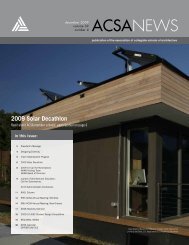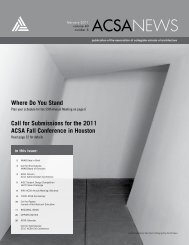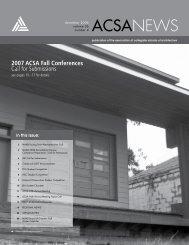digital aptitudes - Association of Collegiate Schools of Architecture
digital aptitudes - Association of Collegiate Schools of Architecture
digital aptitudes - Association of Collegiate Schools of Architecture
Create successful ePaper yourself
Turn your PDF publications into a flip-book with our unique Google optimized e-Paper software.
SATURDAY, MARCH 3, 2012 - 12:30PM - 2:00PM<br />
Society Continued<br />
Spatial ConTXTs<br />
Anda French, Syracuse University<br />
Sibylline TXT (SP2009), What If… (SP2010) and SyrAsks (SP2011)<br />
are three text message based urban installations that explore how<br />
an emerging form <strong>of</strong> mobile communication and its attendant social<br />
models have and can shape the use and understanding <strong>of</strong> “public”<br />
space.<br />
These research projects identify a rapidly changing social-spatial<br />
landscape, which is only visible, comprehensible and accessible<br />
through direct experimentation. The work examines spatial practice<br />
which encourages public interaction. Speculation about the possibility<br />
to heighten, augment or reinforce this practice through the integration<br />
<strong>of</strong> <strong>digital</strong> communications is best served by testing in the public<br />
realm, using the devices directly.<br />
Part 1: Sibylline TXT, my own research project, began the sequence.<br />
This project dispersed a fictional story through 60 separate text messages,<br />
dispersed through 26 urban sites, over 30 days. The project is<br />
named for the Cumaean Sibyl at the Oracle <strong>of</strong> Cumae (seen in Virgil’s<br />
Aeneid). The Sibyl inhabits a cave with one hundred openings, and<br />
reveals her prophesies on a series <strong>of</strong> oak leaves within the cave. When<br />
a wind blows the oak leaves are scattered, thus re-sequencing the<br />
prophesy and creating potential through mis- and reinterpretation.<br />
The project explores the potential <strong>of</strong> <strong>digital</strong> communication to operate<br />
as a modern oracular mode <strong>of</strong> narrative grafted on to physical<br />
spaces in the city.<br />
Part 2: This “Spatial ConTXTs” course sequence was funded by an<br />
Imagining America Grant, meant to support courses pairing scholarly<br />
work with community engagement. These courses focused on the<br />
production <strong>of</strong> installation work that engages mobile communication<br />
technologies. The student installations, What If… and SyrAsks, both<br />
claim that a public can be gathered and encouraged to inhabit the<br />
city through urban “conversations.” These conversations were facilitated<br />
through the dispersal <strong>of</strong> physical installations within the city<br />
that act as collectors and markers <strong>of</strong> the discourse. What If… worked<br />
with vacant storefronts in the city as sites to ask citizens to send texts<br />
speculating on the possibilities for the city. SyrAsks created sculptural<br />
pieces fastened to existing infrastructure to pose questions, created<br />
through our workshops with 7th and 8th graders in one’s <strong>of</strong> the city’s<br />
schools and answered through text message. Both projects culminated<br />
in final projection events that invited all contributors to read the<br />
city’s responses, furthering the recursive nature <strong>of</strong> the work.<br />
As a forward-looking pedagogical model, for students these projects<br />
<strong>of</strong> spatial inquiry with minimal construction, enhanced by their <strong>digital</strong><br />
elements, can provide an opportunity for making the most immediate<br />
effect on the environment. This is work that is both theoretically speculative,<br />
and real and engaging as physical practice. These projects<br />
necessitate immediate engagement for students with the community<br />
and with urban conditions.<br />
The work combines the reality <strong>of</strong> the urban field with design techniques<br />
that rely on quick, fluid work to get on the ground as soon as<br />
possible. It is the experimentation and mobilization <strong>of</strong> theory, a powerful<br />
pedagogical tool, an important future model for the integration<br />
<strong>of</strong> studio teaching and field research within an increasingly complex<br />
set <strong>of</strong> urban conditions.<br />
Digital Apptitutes + Other Openings - Boston, MA - 53








